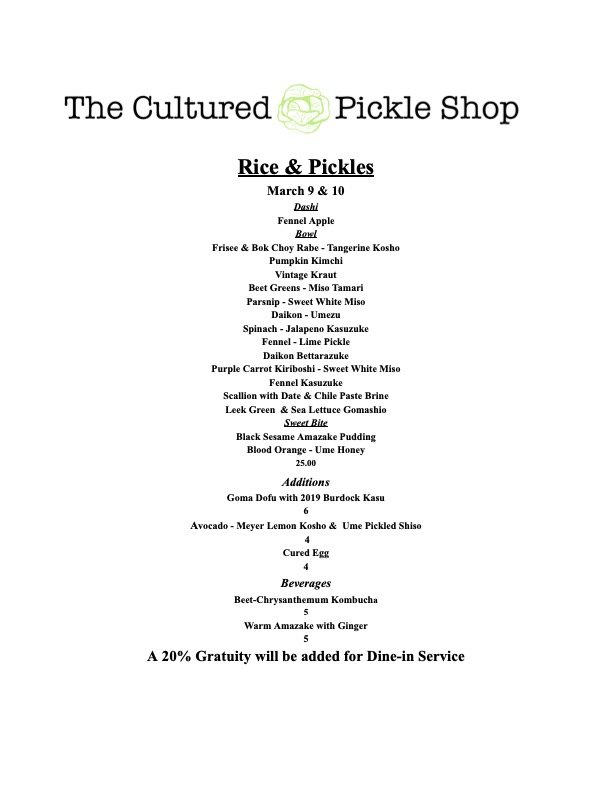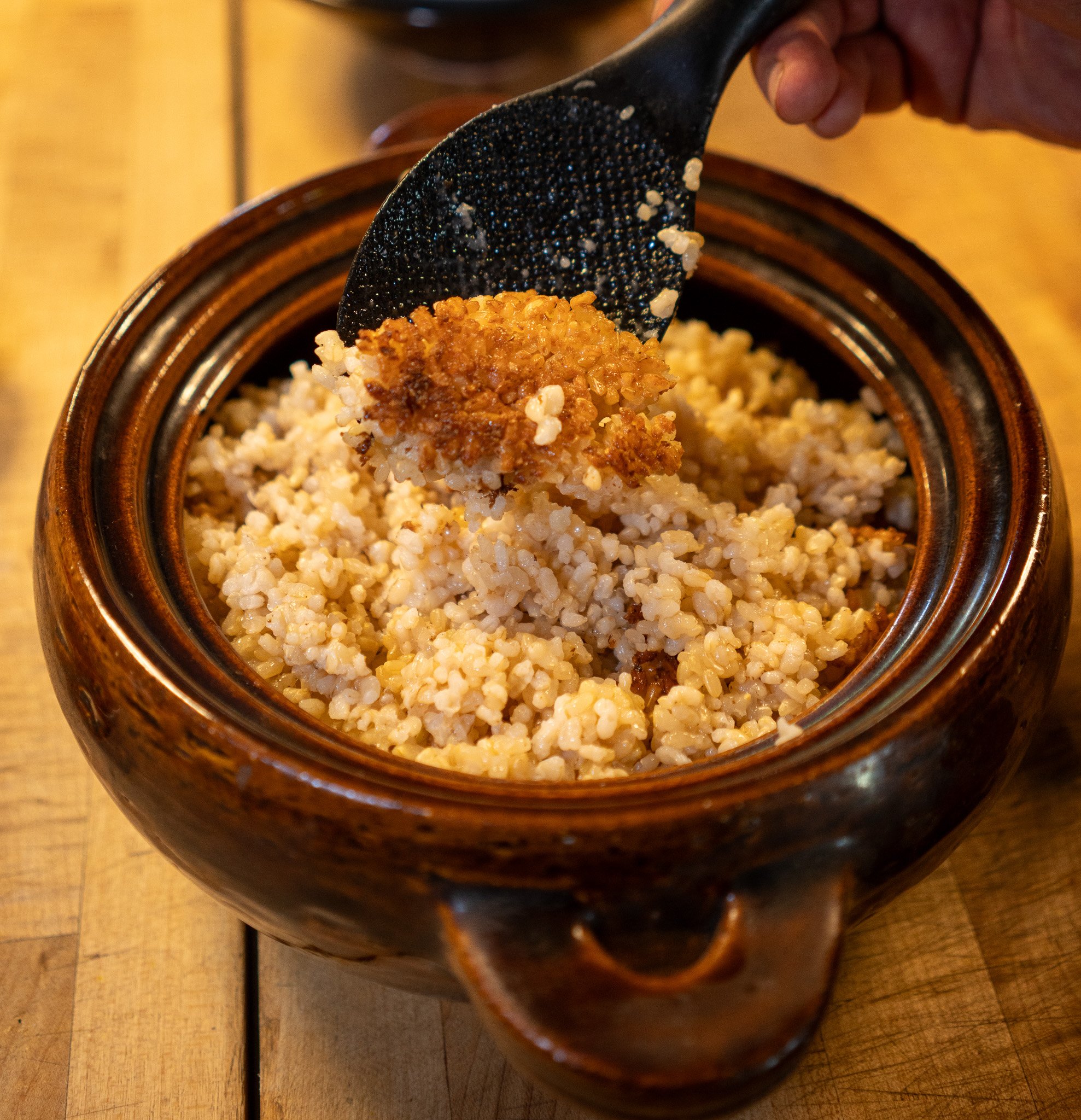Rice & Pickles March 9 & 10
You can click on any of components of the bowl above to identify them. Scroll down for more detail.
When you Dine in with us everything from the Dashi to the Sweet Bite is included in the meal. So, the only decisions you’ll need to make are the additions. We have
Goma Dofu, which translates to Sesame Tofu. Goma Dofu is not a true tofu, in that there is no soy in it. It is made entirely out of Sesame Seeds, which are toasted, ground, pureed with some Dashi, and then heated with Kudzu Root. Kudzu Root is a root starch that acts as a binder and lends a texture to the finished product that is similar to a silken tofu, which is where it gets its name. We also have avocado. The avocados this week are Hass from Brokaw Farm; we top them with Meyer Lemon Kosho and pickled Shiso from our Umeboshi. We also offer a cured egg. We make the eggs every Wednesday. They are a six-and-a-half minute egg that we marinate in a mixture of tamari and shiso vinegar, which is a shiso kombucha that has gone to acetic, or vinegary, to use a beverage, but the shiso flavors are still nice and clean, so we long age it into a mild vinegar mix it with the tamari and sake lees from last years Kabocha squash ferment.
We always begin the bowl with a 50/50 blend of short-grain brown and sweet brown rice, sticky or glutinous brown rice, grown by the Lundberg Family here in California. We cook our rice in a Donabe. Donabe are a family of Japanese clay cooking vessels. The Donabe we use is called a Kamado-san and is specifically designed as a rice cooker. Our Donabe comes from Iga, Japan, and has been made by the Nagatani-en family for 5 generations. Iga is a great location for Donabe making because the clay body that is found in and around Iga has a high microscopic fossil content, which results in superior heat retention in the clay products that come out of the area; so, not only is the Donabe a beautiful and effective rice cooker but it also acts a warmer as it's very slow to cool once it has come off of the flame. We top the rice with a gomashio or sesame salt. Our take on this traditional Japanese toasted sesame and salt condiment is that instead of using salt, we use either one of our ferments that we have dried and powdered or a seaweed. Today, we have toasted sesame seeds and dried and powdered beet pulp left over from juicing beets for kombucha, which gives it color, and we use Sea Lettuce instead of salt.
Parsnip steamed and pureed with a Sweet White Miso that we make at the shop.
Steamed Parsnip
Parsnip Puree seasoned with our Sweet White Miso
Spinach with Jalapeno Kasuzuke
Takara Sake, one of the larger sake producers in our region, is just a few blocks from The Shop. We essentially tap into their waste stream; we get the byproduct from their fermentation, a paste made up of rice, rice koji, and yeast. We take that paste, called kasu or sake kasu, and we add sugar to it to feed the yeast that is still living in it; we add salt to it to moderate the fermentation and for texture preservation, and then we bury vegetables, such as Jalapenos, in it for an average of 12-18 months to make the pickle known as kasuzuke which means pickled in kasu.
Jalapenos fermented in sake lees for 12 months.
prepping jalapeno kasuzuke
Minced Kasuzuke Jalapenos and Spinach
Fennel With Indian Lime Pickle
The fennel bulb was shaved on a mandolin and mixed with our Indian Pickle Lime, which is an 11-month fermentation of limes; they are our version of an Indian achar, like the mango pickle you might get on the side of your dosa. The limes are minced, mixed with the shaved fennel, and left to sit for a few days
Mincing Indian Pickled Limes
Daikon pickled in Umezu
Umezu is the brine from Umeboshi plums also called Ume Vinegar. Daikon is shaved thin on the mandolin and pressed for two days in Umezu.
Pumpkin Kimchi
This has been a favorite Kimchi for us this year. We use a French heirloom pumpkin called a Musquee de Provence or Fairytale, it is a beautiful pumpkin with deep orange color and a subtle melon flavor.
There were two components on this weeks bowl that didn’t make it into the photo above:
Beet Green with Miso Tamari
Blanched & Shocked and mixed with miso tamari, the liquid that rises to the top of the vessel during our Sweet White Miso production
Blanched Beet Greens
Carrot Kiriboshi
Kiriboshi is dried shredded Daikon typically served as a small side dish simmered in dashi. For Kiriboshi at The Shop we use the peels from various vegetables, dry them and simmer them in broth. Last week the puree at the center of the bowl was purple carrot. We peeeled the carrrots before steaming them and reserved the peels. We dried the peels all week and then simmered them on the draining liquid from the purple carrot puree.
Purple carrot puree seasoned with nour sweet white miso. The puree sits in a strainer lined with cheese cloth and we collect any liquid that strains out.
Purple Carrot Peels
liquid collected from straining the puree

















